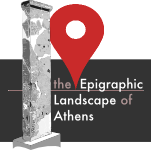IG 2[2] 3174Inscriptiones Graecae II et III: Inscriptiones Atticae Euclidis anno posteriores (2nd ed., Pars I-III, Berlin 1913-1940; Pars V: Berlin 2008), Ed. J. Kirchner, SEG 39, 212 (Follet)Supplementum Epigraphicum Graecum
Inv. number
EM 9559 + EM 4304 + EM 3992
PHI
Translations
AIO, AXON, IG Online
Description
Date
51/0 BCE
Period: 1st century BCE --> middle
✓disputed
Reasons: archon, prosopography
See notesGraindor, RA 6, 1917, 6-7Revue Archéologique, 1844-, ascribed the text to 12/1 BCE observing a close similarity of the letters with those of a text of 14/3 BCE, suggesting that the broken name of the archon mentioned in l. 1 (ἐν τῶι ἐπὶ Λ....δου ἄρχοντος ἐνιαυτ[ῶι]) should be restored with Leonidas, archon of that year. Later Follet proposed to ascribe the inscription to the restoration works undertaken by Diokles "the younger" from Kephissia, who served as priest of Asklepios and Hygieia in 51/0 BCE (Lysiades' archonship); see IG 2[2] 1046Inscriptiones Graecae II et III: Inscriptiones Atticae Euclidis anno posteriores (2nd ed., Pars I-III, Berlin 1913-1940; Pars V: Berlin 2008), Ed. J. Kirchner = ELA id: 222. She thus restored l. 1 as follows: [Διοκλῆς Διοκλέου]ς Κηφισιεὺς ἱερεὺς γενόμενος ἐν τῶι ἐπὶ Λ[υσιά]δου ἄρχοντος ἐνιαυτ[ῶι]. In spite of this, some recent works still attribute the text to 12/1 BCE (e.g. Melfi 2007 422 no. 146Melfi, M., «I santuari di Asclepio in Grecia I», (Studia Archaeologica 157), Roma 2007; Ma, Tekmeria 9, 2008, 14 fn. 25Τεκμήρια: συμβολὲς στὴν ἱστορία τοῦ Ἑλληνικοῦ καὶ Ῥωμαϊκοῦ κόσμου, 1995-), so that the issue is still unsolved. The formula restored by Follet, although plausible, lacks the definition of Diokles as νεώτερος, as he is remembered four times in IG 2[2] 1046Inscriptiones Graecae II et III: Inscriptiones Atticae Euclidis anno posteriores (2nd ed., Pars I-III, Berlin 1913-1940; Pars V: Berlin 2008), Ed. J. Kirchner (ll. 11, 20, 24, 28).
On Diokles "the younger" and his family see Aleshire 1989 214 and fn. 1Aleshire S.B., «The Athenian Asklepieion. The People, their Dedications, and the Inventories», Amsterdam 1989; Aleshire 1991 105-106 no. 4032Aleshire S.B., «Asklepios at Athens. Epigraphic and Prosopographic Essays on the Athenian Healing Cults», Amsterdam 1991; SEG 57, 114Supplementum Epigraphicum Graecum
Text category
building inscription, dedication
See notesThe inscription bears a dedication to Asklepios and Hygieia by a priest of the two healing gods coming from Kephissia. It regards some restorations undertaken by the dedicator on a building in the precinct ([- - - τὸν π]ροσκείμενον οἶκον) and an exedra. It is the first attestation of an exedra in the Asklepieion of Athens, perhaps to be associated to a dining hall or room with couches (see Ma, Tekmeria 9, 2008, 13-14Τεκμήρια: συμβολὲς στὴν ἱστορία τοῦ Ἑλληνικοῦ καὶ Ῥωμαϊκοῦ κόσμου, 1995-).
It is likely that the repairs here mentioned should be attributed to Diokles "the younger" or to a member of his family and that the text should be associated, at least chronologically, to IG 2[2] 1046Inscriptiones Graecae II et III: Inscriptiones Atticae Euclidis anno posteriores (2nd ed., Pars I-III, Berlin 1913-1940; Pars V: Berlin 2008), Ed. J. Kirchner. Nevertheless, as cleverly remarked by Melfi 2007 361Melfi, M., «I santuari di Asclepio in Grecia I», (Studia Archaeologica 157), Roma 2007, the text seems to deal with facilities of the precinct different from those mentioned in IG 2[2] 1046Inscriptiones Graecae II et III: Inscriptiones Atticae Euclidis anno posteriores (2nd ed., Pars I-III, Berlin 1913-1940; Pars V: Berlin 2008), Ed. J. Kirchner, that is the entrance doors to the temple, the roof behind a propylon of the precinct and the cella of the shrine of Asklepios and Hygieia. The adjoined "oikos" and the exedra, both still unattested archeaologically, were most probably restored by Diokles in addition to the specific repairs of IG 2[2] 1046Inscriptiones Graecae II et III: Inscriptiones Atticae Euclidis anno posteriores (2nd ed., Pars I-III, Berlin 1913-1940; Pars V: Berlin 2008), Ed. J. Kirchner and our text may thus reveal an even more ambitious and large program of restorations undertaken by him on the Asklepieion in the middle of the I cent BCE.
Contra, Follet (as quoted in SEG 39, 212Supplementum Epigraphicum Graecum) and Aleshire 1991 106Aleshire S.B., «Asklepios at Athens. Epigraphic and Prosopographic Essays on the Athenian Healing Cults», Amsterdam 1991 identified the "oikos" with the elements of the propylon mentioned in IG 2[2] 1046Inscriptiones Graecae II et III: Inscriptiones Atticae Euclidis anno posteriores (2nd ed., Pars I-III, Berlin 1913-1940; Pars V: Berlin 2008), Ed. J. Kirchner, especially with the roofed rear hall of the propylon; see also REG (BE) 1991, 69Bulletin épigraphique (dans la Revue des Études Grecques), 1888-.
Monument description
Monument type: epistyle
Material: marble
Original dimensions: h: 0.155 * w: ca. 1.62 * t: 0.15-0.16 - (reconstruction)
✓ornamentation
Letters Height Mt: 0.03
The fragments were part of an epistyle block. The bottom surface is decorated with a pearls and ovolos moulding for the reuse of the stone in an Early Byzantine basilica.
Photos in Follet, as quoted in SEG 39, 212Supplementum Epigraphicum Graecum, pl. 6, figs. 1 and 4
Physical features
Measurements: h: 0.155 * w: 0.56 * t: 0.15
State of conservation: Top and bottom preserved
Legibility: Very good. Left portion of two lines of text
Reuse: Reused as building material
Signs of reuse: Late moulding (bottom surface)
See notesPhoto in RA 6, 1917, 6, fig. 5aRevue Archéologique, 1844- (squeeze); Follet, as quoted in SEG 39, 212Supplementum Epigraphicum Graecum, pl. 6 fig. 2, pl. 7
Measurements: h: 0.155 * w: 0.48 * t: 0.06
State of conservation: Top, bottom and back preserved
Legibility: Good. Middle portion of two lines of text
Reuse: Reused as building material
Signs of reuse: Late moulding (bottom surface)
See notesPhoto in RA 6, 1917, 7, fig. 5bRevue Archéologique, 1844- (squeeze); Follet, as quoted in SEG 39, 212Supplementum Epigraphicum Graecum, pl. 6, figs. 2-3
Measurements: h: 0.155 * w: 0.54 * t: 0.16
State of conservation: Top and bottom preserved
Legibility: Good. Right portion of two lines of text
Reuse: Reused as building material
Signs of reuse: Late moulding (bottom surface)
See notesPhoto in RA 6, 1917, 7 fig. 5cRevue Archéologique, 1844- (squeeze); Follet, as quoted in SEG 39, 212Supplementum Epigraphicum Graecum, fig. 3
Findspot
Found south of the Propylaia in the site once occupied by a temple of Demeter. Such temple, dedicated to Demeter Chloe, most probably stood on the same terrace of the attested sanctuary of Aphrodite Pandemos, just beneath the temple of Athena Nike. After the discovery Frg. a was stored in the Pinacotheca; see APMA 5 no. 1346Malouchou G.E., «Εφημερίς Αρχαιολογική. Ευρετήρια περιόδου πρώτης 1837-1860» (AΡΜΑ V, Βιβλιοθήκη της εν Αθήναις Αρχαιολογικής Εταιρείας αρ. 265), Αθήναι 2010.
Follet, as quoted in SEG 39, 212Supplementum Epigraphicum Graecum, suspects that Frg. a was actually found in the area of the Asklepieion and not by the sanctuary of Demeter mentioned by Pittakis.
Date of discovery: 1834
Circumstances: archeological excavation
Pittakis, AEph 1853, 1004 no. 1804Ἀρχαιολογικὴ ἐφημερίς: περιοδικὸν τῆς ἐν Ἀθήναις Ἀρχαιολογικῆς Ἑταιρείας, 1837- = IG 2 396Inscriptiones Graecae II: Inscriptiones Atticae aetatis quae est inter Euclidis annum et Augusti tempora. (Voll. I-IV, Berlin 1877-1893). Ed. U. Koehler
On the sanctuary of Demeter Chloe see Paus. I, 22, 3Pausanias, «Hellados Periegesis»; Topografia di Atene, 1 190E. Greco (a cura di), «Topografia di Atene. Sviluppo urbano e monumenti dalle origini al III sec. a.C.», Tomo 1: «Acropoli - Areopago - Tra Acropoli e Pnice», Atene-Paestum 2015 .
✓unknown
Date of discovery: <1910's
Circumstances: archeological excavation
Graindor, RA 6, 1917, 6 no. 5Revue Archéologique, 1844- = IG 2[2] 3174bInscriptiones Graecae II et III: Inscriptiones Atticae Euclidis anno posteriores (2nd ed., Pars I-III, Berlin 1913-1940; Pars V: Berlin 2008), Ed. J. Kirchner
Formerly known as: Stoa of Hadrian
The fragment had been probably stored in what was called the "Stoa of Hadrian", but the original provenance is unknown.
Date of discovery: <1870's
Circumstances: museum / collection
Koehler, IG 2 99Inscriptiones Graecae II: Inscriptiones Atticae aetatis quae est inter Euclidis annum et Augusti tempora. (Voll. I-IV, Berlin 1877-1893). Ed. U. Koehler
Original location
The inscription arises more problems on the already complicated topography of the Asklepieion in the mid I cent. BCE. Nevertheless, its original location cannot be precisely identified, seeing that reuses and other circumstances brought the three fragments away, sometimes even faraway, from the site of the precinct. It may be surmised that the inscribed epistyle decorated one of the two facilities repaired inside the precinct by the dedicator.
Adjoined "oikos" inside the precinct of Asklepios (l. 2);
Exedra inside the precinct of Asklepios (l. 2)


